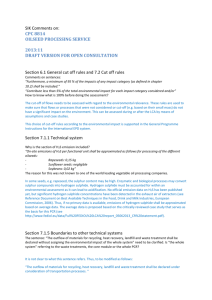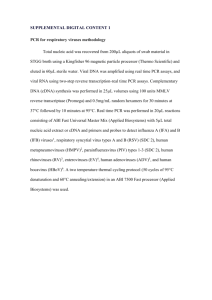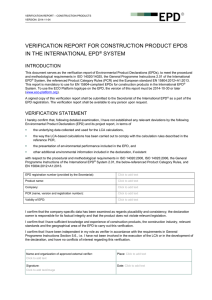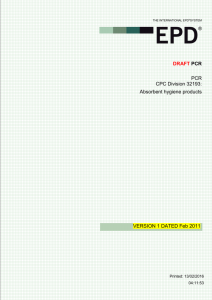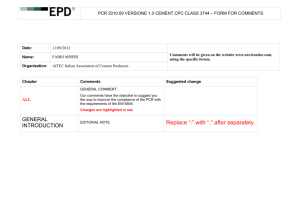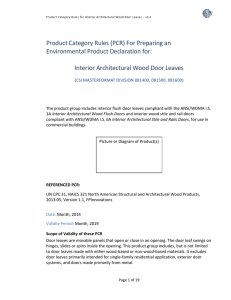SIK Comments on vegetable oil refining PCR reply
advertisement
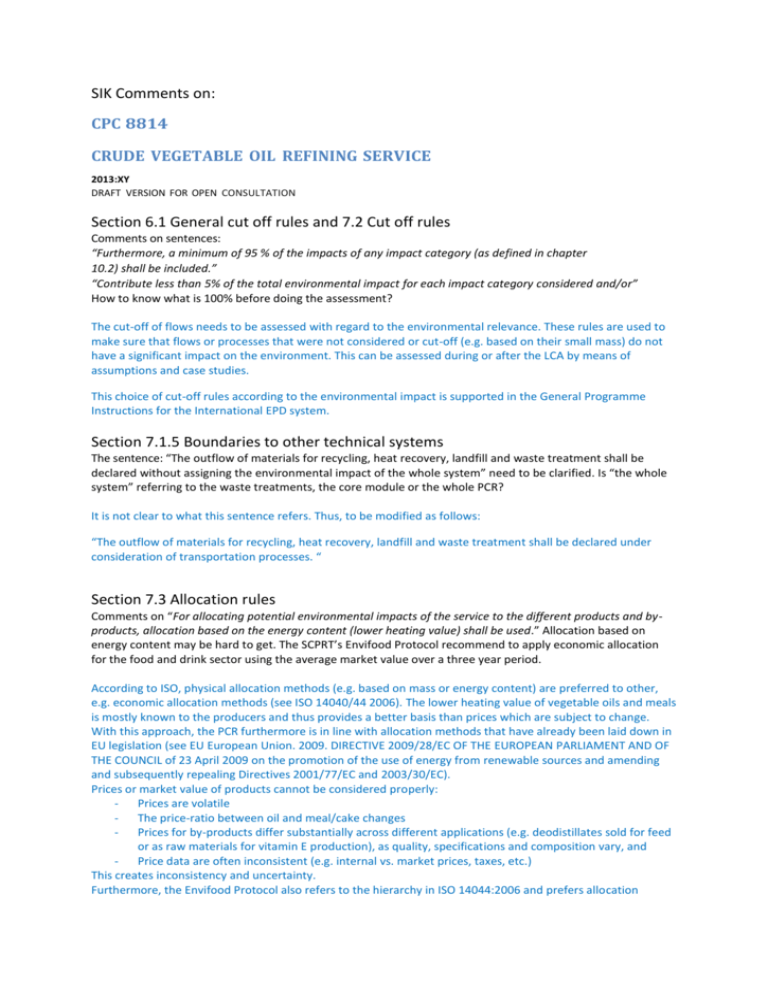
SIK Comments on: CPC 8814 CRUDE VEGETABLE OIL REFINING SERVICE 2013:XY DRAFT VERSION FOR OPEN CONSULTATION Section 6.1 General cut off rules and 7.2 Cut off rules Comments on sentences: “Furthermore, a minimum of 95 % of the impacts of any impact category (as defined in chapter 10.2) shall be included.” “Contribute less than 5% of the total environmental impact for each impact category considered and/or” How to know what is 100% before doing the assessment? The cut-off of flows needs to be assessed with regard to the environmental relevance. These rules are used to make sure that flows or processes that were not considered or cut-off (e.g. based on their small mass) do not have a significant impact on the environment. This can be assessed during or after the LCA by means of assumptions and case studies. This choice of cut-off rules according to the environmental impact is supported in the General Programme Instructions for the International EPD system. Section 7.1.5 Boundaries to other technical systems The sentence: “The outflow of materials for recycling, heat recovery, landfill and waste treatment shall be declared without assigning the environmental impact of the whole system” need to be clarified. Is “the whole system” referring to the waste treatments, the core module or the whole PCR? It is not clear to what this sentence refers. Thus, to be modified as follows: “The outflow of materials for recycling, heat recovery, landfill and waste treatment shall be declared under consideration of transportation processes. “ Section 7.3 Allocation rules Comments on “For allocating potential environmental impacts of the service to the different products and byproducts, allocation based on the energy content (lower heating value) shall be used.” Allocation based on energy content may be hard to get. The SCPRT’s Envifood Protocol recommend to apply economic allocation for the food and drink sector using the average market value over a three year period. According to ISO, physical allocation methods (e.g. based on mass or energy content) are preferred to other, e.g. economic allocation methods (see ISO 14040/44 2006). The lower heating value of vegetable oils and meals is mostly known to the producers and thus provides a better basis than prices which are subject to change. With this approach, the PCR furthermore is in line with allocation methods that have already been laid down in EU legislation (see EU European Union. 2009. DIRECTIVE 2009/28/EC OF THE EUROPEAN PARLIAMENT AND OF THE COUNCIL of 23 April 2009 on the promotion of the use of energy from renewable sources and amending and subsequently repealing Directives 2001/77/EC and 2003/30/EC). Prices or market value of products cannot be considered properly: Prices are volatile The price-ratio between oil and meal/cake changes Prices for by-products differ substantially across different applications (e.g. deodistillates sold for feed or as raw materials for vitamin E production), as quality, specifications and composition vary, and Price data are often inconsistent (e.g. internal vs. market prices, taxes, etc.) This creates inconsistency and uncertainty. Furthermore, the Envifood Protocol also refers to the hierarchy in ISO 14044:2006 and prefers allocation reflecting the physical relationships of different products. Only if physical relationships CANNOT be established, the Envifood Protocol specifies that economic allocation, using a price average over a three year period, shall be used by default. Section 7.5 Rules for generic data Clarify the sentence “Generic data used shall not exceed 10% of the core module life cycle inventory.” How do you measure 10% of inventory? 10% of total input posts? 10 % of total weight? Better expression: “The environmental impacts associated to generic data must not exceed 10% of the overall environmental impact from the product system.” The sentence will be changed as proposed: “The environmental impacts associated to generic data must not exceed 10% of the overall environmental impact from the service system.” Contradiction in Section 7.4, 8.2 and 9.2 Site specific data shall be used for the core module production site and generic data shall be used for energy mix and wastewater treatment. If a company actively uses only sustainable energy sources and waste water treatment technologies this will then not be shown in the PCR result. What will then be the driving forces for a company to use the PCR? Will only amounts of energy use and waste water then matter? The PCR states (section 8.2) that “site-specific data for energy generation and use can be reported separately”. Furthermore, the PCR states (section 9.2) that “site-specific methods of waste or wastewater treatment can be reported separately”. This enables companies to specify individual energy sources or wastewater treatment methods in an annex to the EPD. This proceeding is based on two reasons: 1. The goal of a PCR is to create comparability. If site specific modeling of energy and waste streams would be allowed, specific guidance on how to do so and how to deal with renewable energies, recovery systems etc. would need to be given to enable a comparison of the EPDs. In the context of the multifold possibilities this cannot be achieved in an acceptable manner. 2. As many companies rely on the energy grid mix, results of the LCA would be determined to a large extent by the country of production and not the performance of the company. Thus, energy efficiency would not be honored, while very “dirty” companies in a country with a good energy mix would a better performance. Thus, specifications are given in the PCR. However, to enable companies that use sustainable energy resource to report their doing, the inclusion of an annex to the EPD is specifically mentioned in the PCR. This will provide the opportunity to communicate the own performance and to highlight potential emission savings, etc. Section 10.2 Potential environmental impacts The suggested characterization method is CML providing impact units for each environmental impact category as stated in the EPD General Program Instructions. This not in alignment with the other European Environmental footprint initiatives (The EU commissions JRC Product Environmental Footprint & SCPRT’s Envifood Protocol) that recommend the ILCD characterization methods and rule out comparability. The selection of impact categories is based on internationally accepted, commonly applied methodologies and is recommended by the Programme Operator. The characterization methods proposed in the Envifood Protocol or in the PEF-document are often not applicable as of today (see http://download.springer.com/static/pdf/893/art%253A10.1007%252Fs11367-013-0678x.pdf?auth66=1389885665_72191e7a330369b4f3b31430c2884c2e&ext=.pdf). Section 10.5 Presentation of the LCA results Not only the production BUT the use of energy is important The use of energy is of course the reason for the energy production/generation. However, environmental impacts result from the production of the energy and occur during the production and not the use as such. Thus only the production is named here. SIK, 14th Jan 2014 Katarina Nilsson, PhD SIK - the Swedish Institute for Food and Biotechnology Business Manager, Sustainable Food Production email: kn@sik.se
